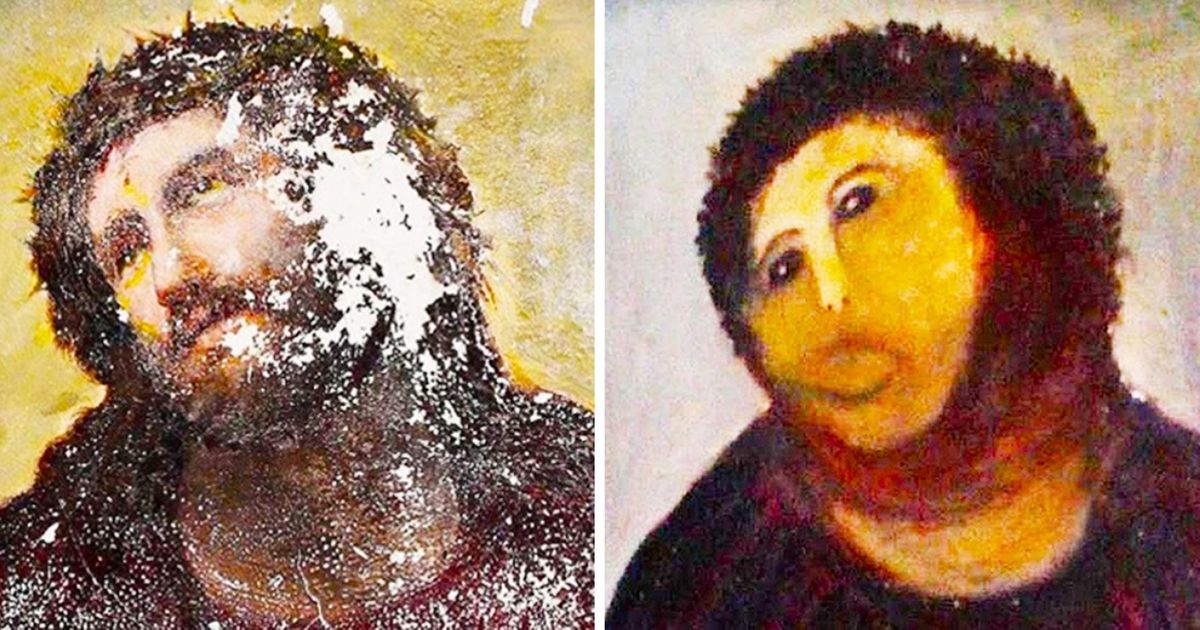Art Is Subjective, But These Art Restorations Are Objectively Bad
Who among us has never ever lied on their resume? I’ve definitely said I am a certified commercial driver’s license holder in order to get a job at a car dealership. I have also said on multiple occasions that I enjoy working with the public, so whoever is without sin feel free to cast the first stone.
However, I feel like things get a little bit more serious when we’re talking about bad art restorations. Recently there have been a few terrible restorations that make headlines because they are so poorly done. Can you imagine doing your job so badly that you turn a beautiful piece of art into a meme?
The Great Wall of China.
As the largest architectural monument on Earth, the Great Wall of China attracts millions of visitors each year. Unfortunately, it is also decaying from hosting so many people and just the passing of time taking its toll. Restorers unsuccessfully tried to reconstruct one of the most beautiful sections of the wall simply by covering it in concrete.
The repairs were carried out in 2014 and smooth over the wall but this repair job is so ugly you can see it from space. The reconstruction was stopped, and the case is being investigated the rest of the wall will be restored much more carefully. There have been efforts to crowdfund correction of the wall, which attracted $18,000 in one day.

Castle of Matrera.

The reconstruction of the ancient fortress of Matrera turned out god-awful. The restorer, Carlos Quevedo, said he wanted to make it clear which parts of the fortress were new and which were ancient. An authoritative community of architects took the side of the restorer but the locals are definitely not happy.
The tower had partly collapsed a few years before the restoration, so the project was aimed at building up the castle’s Tower. New materials were used to protect the ruins and give the tower its original shape and dimensions. It’s against Spanish law to imitate the original structure when restoring a building so the architect wasn’t wrong to build it this way.
Saint George Statue


The statue of Saint George slaying a dragon has been at the Saint Michael Estella church for over 500 years. During this time, the wooden statue definitely received a fair amount of damage. Unfortunately in 2018, an art teacher attempted to restore the statue by simply painting over it. The colors were completely incorrect and when working on St. George’s face she made him look more like a plastic toy than a statue.
The art teacher not only used the wrong type of paint, but her misstep was going to destroy the original layers of paint on the statue. The mayor of the city had to step in to control the situation because of how set upset the community was. An actual team of restoration experts ended up taking on the project and fixing the damage she had done. The art teacher’s painting project cost $34,000 to fix.
Technicolor Spanish Statues
Spain just keeps refusing to learn its lesson about restoring religious artworks. The restoration of these Spanish statues came only months after the botched restoration of St. George. The restoration of these beautiful wooden statues was done by a local tobacco shop owner who was definitely not a professional art restorer. These wooden statues have recently been restored only a few years before.
The tobacco shop owner said she wanted to add some color, and she definitely lived up to her promise. Not only did she change all of the colors to neon, but all of the colors absolutely clash. The woman inexplicably added thick makeup to the statues, featuring eyeliner drawn on eyebrows, and very dark lipstick. When asked about the statue, she replied that she was not a restoration professional. We could definitely tell.
Tutankhamun’s beard.

In 2014, an employee of the Cairo Museum dropped the golden mask of King Tut, breaking the beard off from the relic. The employee’s husband was an art restorer and instead of going to professionals, she turned to him to fix the 30-pound mask.
The “restorer” put the beard back on with superglue, and even worse: at the wrong angle. The beard was stained with the glue he used and decided to try to scrape it off, making many scratches on it. Since these mistakes, the mask has been restored properly.
Mars and Venus.
In 2010, Prime Minister Silvio Berlusconi ordered workers to install the statues of Mars and Venus (circa 175 AD) in front of his residence. The statues were discovered to have missing body parts, so the Prime Minister ordered them to be restored.
Art critics did not appreciate the Prime Minister’s desire to restore these items, as he completely replaced missing parts including Venus’s hand and Mars’ penis. The Prime Minister said the new parts were magnetic and could be easily removed again. After this criticism toward the reconstruction, it is said that Mars and Venus were returned to their initial damaged state.
Ecce Mono / Jesus Fresco.

80-year-old Cecilia Jimenez attempted to restore a mural of Jesus in a local Spanish Cathedral. After the restoration, it did not look like the original painting at all. Cecilia’s brush skills were not quite up to the job. The mural, called Ecco Homo, was definitely ruined as her handiwork was irreversible, but the kitchen Cathedral became known worldwide for this painting.
Crowds have now swarmed the cathedral to see the restoration paying the sanctuary of Mercy Church a few dollars each to see it. The church leaned into their popularity selling mugs t-shirts and other items with the picture of the bad restoration on them. The church was able to fund a home for senior citizens with the money. The restorer has also requested to receive a portion of the ticket sales.
The painting has now also been memed into oblivion.

Frescoes in the Sistine Chapel.
One of the most extensive restoration projects in the 20th century was the restoration of the Sistine Chapel. When the project masters were clearing what they believed to be soot, they touched the top layer of the frescoes.
Michelangelo himself had made corrections on top of the plaster that was now scrubbed off. Some of the characters lost their eyes in the process, making them look blind. The entire Sistine Chapel has now been digitized for further restoration work.
The Virgin and Child with St. Anne.

Da Vinci painting The Virgin and Child with St. Anne was restored and came out much lighter than the unrestored version The earlier painting was cloudy and it was believed that Da Vinci’s vision was of a stormy day.
The revision of the painting is dominated by bright colors appearing to take place on a sunny day. Some experts at the Louvre quit their jobs in protest against such an inappropriate restoration, including Ms. Bergeon Langle, one of the world’s leading experts in painting conservation.
Ghent Altarpiece Lamb of God
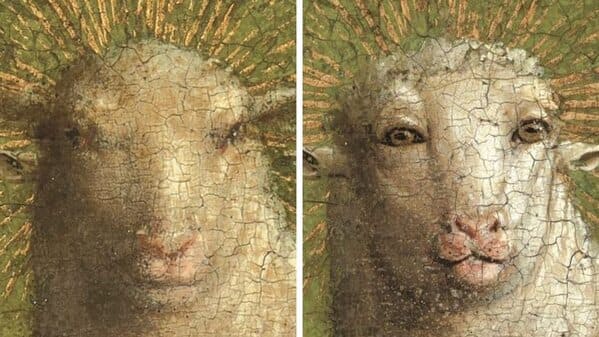
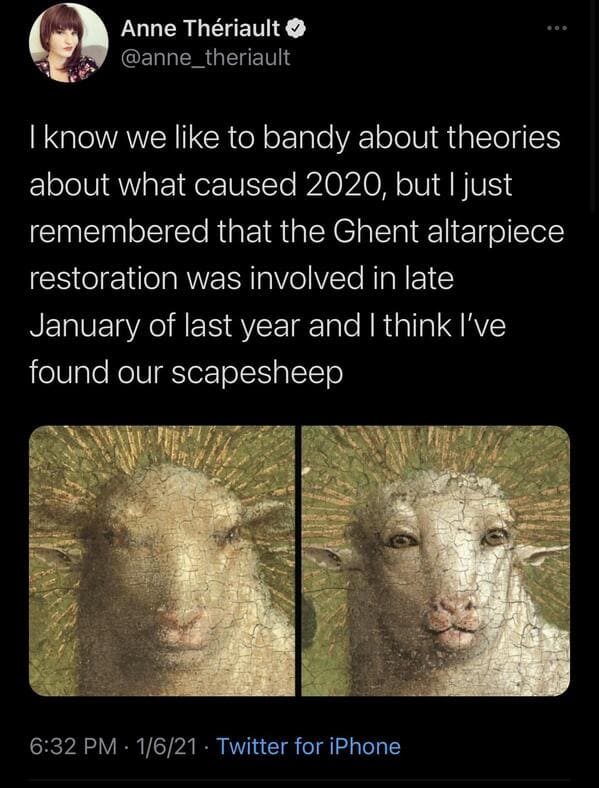
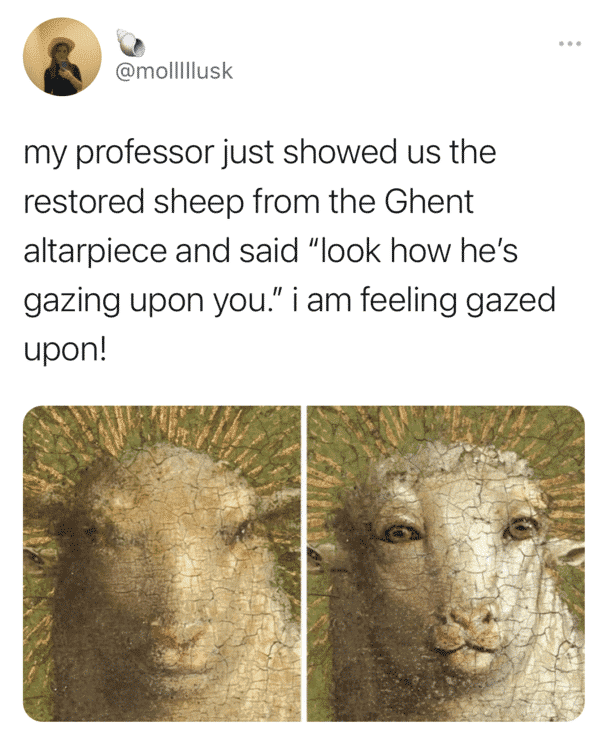
The Ghent Altarpiece Lamb of God was completed by Hubert and Jan Van Eyck in 1432 and is housed in Belgium. It was the first oil painting to have global fame.
Since 2002, a $2.4 million dollar project was started to restore the artwork at the Museum in Belgium. During the restoration, workers found that the original lamb had been painted over in the 16th century. After stripping away the cover-up, conservationists found the lamb with a much more intense gaze, large frontal eyes, and a cartoonish depiction.
The restoration was completed in December 2019, but the results started to move through social media in January 2020.
The Virgin Mary and Baby Jesus.
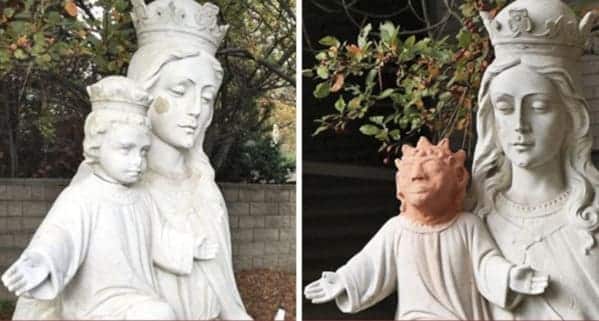
The sculpture of the Virgin Mary and baby Jesus in Sudbury Canada was damaged by Vandals. Baby Jesus’ head was chipped off and stolen. A volunteer offered to make a new head but the work looked very strange and upset the locals. It even upset the vandal so much that he brought the original head back to fix it. The sculpture is now restored.

